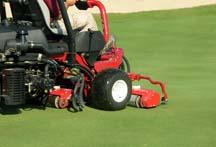According to a three-year study conducted by researchers at Rutgers University, a program of lightweight rolling not only can help superintendents produce truer, firmer greens, it also can aid in reducing the incidence of anthracnose in annual bluegrass putting surfaces.
Results of the three-year study, which occurred in 2006-08, were posted in mid-2012 in Agronomy Journal.
 The objective of the study was to determine the influence of different types of rollers and their location on the green on turf quality and anthracnose development in annual bluegrass. Previous studies have shown a wide array of results, including hampered turf quality under a program of double rolling four to seven days per week, as well as studies showing no negative impact from lightweight rolling programs.
The objective of the study was to determine the influence of different types of rollers and their location on the green on turf quality and anthracnose development in annual bluegrass. Previous studies have shown a wide array of results, including hampered turf quality under a program of double rolling four to seven days per week, as well as studies showing no negative impact from lightweight rolling programs.
In the Rutgers study, undertaken by Bruce Clarke, Ph.D., Jim Murphy, Ph.D., and Joseph Roberts, vibratory rollers attached to a triplex mower and sidewinder rollers were used along the center and perimeter of each putting surface. The study also included an unrolled control plot.
The plot was initially inoculated with anthracnose two years before the study began and sand topdressing was applied bi-weekly from May to September each year of the study. Plots were rolled every other day after mowing throughout the growing season in all three years of the study.
Disease outbreak consistently was more severe in the center of the plots throughout the duration of the study, and roller type had no significant effect on increased disease severity. In fact, incidence of anthracnose often was reduced due to rolling.
Contrary to some previous studies indicating that lightweight rolling could result in compaction, the Rutgers study showed no increase in soil bulk density. Only location affected soil bulk density, with perimeter plots showing an increase. So, while soil bulk density in the perimeter plots increased, the incidence of anthracnose in those areas due to rolling did not.
The researchers concluded the increased compaction in the perimeter plots could be due to clean-up passes, directional changes and both vibratory and sidewinder rollers can be used to increase ball speed without promoting, and sometimes reducing anthracnose severity.

